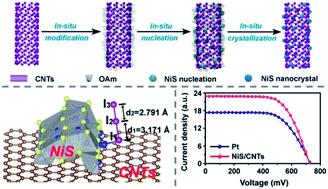Carbon nanotubes in situ embedded with NiS nanocrystals outperform Pt in dye-sensitized solar cells: interface improved activity†
Abstract
Designing a Pt-free counter electrode (CE) electrocatalyst with superior catalytic activity for triiodide (I3−) reduction and electrochemical stability for dye-sensitized solar cells (DSSCs) is always challenging. An active-site-enriched NiS/multiwalled carbon nanotube (CNT) composite was synthesized using small-sized NiS nanoparticles in situ embedded in CNTs through the hot-injection method. A DSSC fabricated with the NiS/CNT CE exhibited an excellent activity to I3− reduction with a surprising photoelectric conversion efficiency (PCE) of 10.82%, outperforming Pt (8.03%). The superior catalytic activity and stability of NiS/CNTs were also observed from electrochemical characterization. DFT calculations revealed that this satisfactory activity was mainly attributed to the appropriate binding energy of I3− on the Ni atoms of the embedded NiS at the unique NiS–CNT interface. Moreover, the strong bonding in the NiS and CNT interface with reduced work function facilitated electron delocalization from embedded NiS nanoparticles to the C walls of CNTs, where the charge-transfer ability was improved. Thus, the as-synthesized NiS/CNT composite is a promising CE material to replace the expensive Pt electrocatalyst in DSSCs.



 Please wait while we load your content...
Please wait while we load your content...